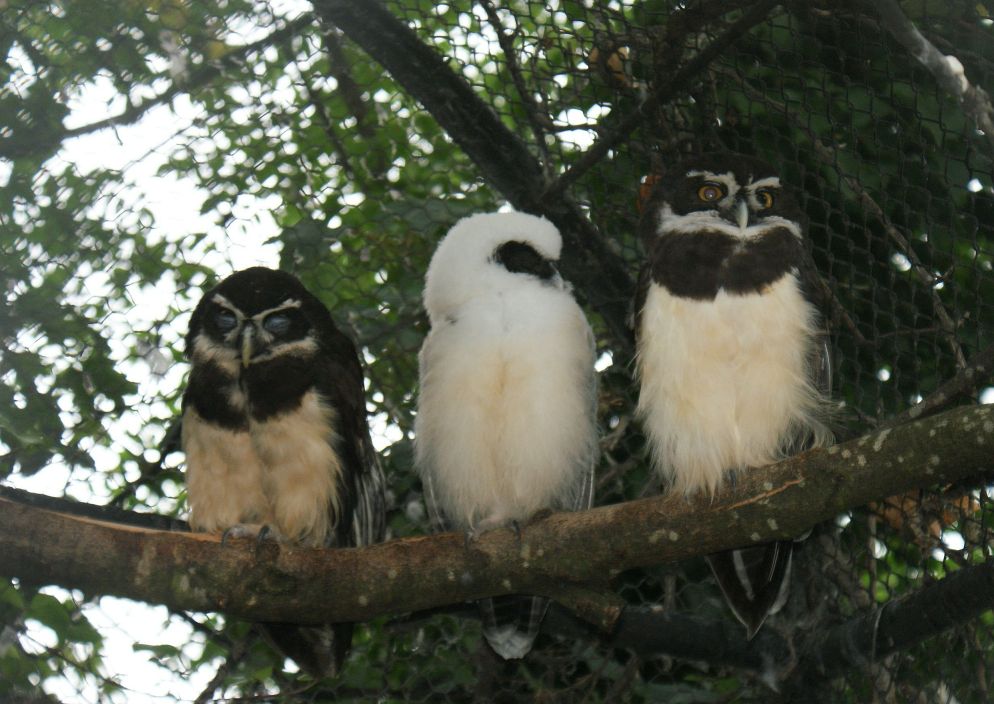Spectacled Owl
| Spectacled Owl | |||
|---|---|---|---|
| メガネフクロウ | |||
| Character Data | |||
| Romaji | Megane fukurou
| ||
| Debut | Kemono Friends (2015 Game) | ||
| Animal Data | |||
| Scientific Name | Pulsatrix perspicillata
| ||
| Distribution | the Americas
| ||
| Diet | Carnivore
| ||
| Avg. Lifespan | 35 years
| ||
| Read More | Spectacled owl
| ||
| Conservation | 
| ||
| Spectacled Owl | Nexon Game |
The Spectacled Owl is a type of bird Friend that appeared in the original Kemono Friends mobile game. She has not appeared in any Kemono Friends media since.
Appearance
Spectacled Owl has short black hair with darker tones on the tips of her wings and to the sides of her front bangs. Further in details, she borrows some appearance traits from the animal she's based on, the beak is represented by her yellow-tinted forelock and the bird's eyes are represented by the glasses she's wearing along with the white stripes on her fronthead and to the side of her bangs. Similarly to the bird, her owl's tail is striped beige and raw amber. Her eyes are yellow.
Her outfit is composed of an apron-like dress with fur around the edges, a fur-like collar with a medium-sized red bow. Inside her dress, she wears a dark blouse on which the sleeves are patterned like the owl plumage, with curved hatchings. She also wears yellow-brown leggings, light-yellow gloves, and fur boots with small-sized red ribbons on them. She wields a wooden geologist's hammer.
Series Appearances
| Media | Role | |
|---|---|---|
In Real Life
The Spectacled Owl is a large owl native to the neotropics. It can be found in Mexico, several parts of Central America (including Guatemala, El Salvador, Nicaragua, and Panama) and South America (incl. Colombia, Venezuela, Paraguay, Peru, Brazil, and Argentina). The primary habitat is tropical rainforests, with old-growth forests being a favorite.
Being one of the bigger owl species, they can range from 41 to 52.3 cm (16.1 to 20.6 in) in length. Males typically weigh 453 to 1,075 g (1.00 to 2.37 lb.), whereas females can weigh 680 to 1,250 g (1.50 to 2.76 lb.). Their most distinctive features is the white markings around its eyes, resembling glasses (hence the name). Young Spectacled Owls are even more distinct, being completely stark white save for soft brown "discs" around the eyes.
Vocal activity tends to be most prominent on calm, moonlit nights. The signature sounds consists of guttural knocking or tapping sounds with a popping effect. Each note becomes progressively weaker and lower in pitch but faster in pace as the call continues. Males are more likely to make the vocalization but females will as well, with theirs being higher in pitch. Females can also emit a hawk-like screech which has been compared to a train whistle.
Like most owls, Spectacled Owls are nocturnal, starting activity right around the time of last light at dusk and usually being back on their roosts for the day around first light. They are not very social, tending to stay alone unless it's mating season. Little is known how they interact with other owls, but a study where playback of a number of owl species were played in Costa Rica, spectacled owls appeared to the least responsive, neither vocally stimulated by the calling of other owl species nor by playback of calls of their own species.
An omnivorous species, their diet consists of rodents, possums, the occasional bat, frogs, and insects such as caterpillars and spiders.
.
Trivia
- There are six (6) total subspecies of Spectacled Owl.
- The Tawny-browed owl bears a striking resemblance to the Spectacled owl, the main physical difference being the eye markings are a cocoa brown instead of white.
- In Brazil, spectacled owls are known locally as "knocking owls".
- There was a report of a Spectacled Owl killing a three-toed sloth, which was at least three times the size of the bird.
References
- Wikipedia Page
- BirdLife International (2018). "Pulsatrix perspicillata". IUCN Red List of Threatened Species. 2018: e.T22689180A130161018. doi:10.2305/IUCN.UK.2018-2.RLTS.T22689180A130161018.en. Retrieved 11 November 2021.
- Owls of the World: A Photographic Guide by Mikkola, H. Firefly Books (2012), ISBN 9781770851368
- Bourton, Jody (4 February 2010). "Wild sloth killed by small spectacled owl in Panama". BBC News. Retrieved 13 October 2020.
- Enriquez, P. L., & Salazar, J. L. R. (1997). Intra-and Interspecific Calling in a Tropical Owl Community. UNITED STATES DEPARTMENT OF AGRICULTURE FOREST SERVICE GENERAL TECHNICAL REPORT NC, 525-532.


